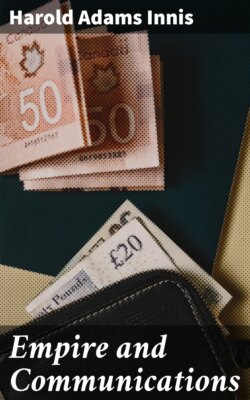Читать книгу Empire and Communications - Harold Adams Innis - Страница 8
На сайте Литреса книга снята с продажи.
Footnote
ОглавлениеTable of Contents
[19] Cited Alexander Moret, The Nile and Egyptian Civilization (London, 1927), p. 375.
[20] See Patrick Boylan, Thoth, the Hermes of Egypt (London, 1922).
[21] S. H. Hooke, ‘The Early History of Writing’ (Antiquity, xi, 1937, p. 266).
[22] The dating system used herein follows Moret.
[23] A. M. Hocart, Kingship (London, 1927), p. 55.
[24] Naphtali Lewis, L'Industrie du papyrus dans l'Égypte Gréco-Romain (Paris, 1934), p. 117.
[25] Alfred Lucas, Ancient Egyptian Materials and Industries (London, 1934), pp. 133 ff.
[26] Alexander Moret, The Nile and Egyptian Civilization (London, 1927), p. 457 n.
[27] Lynn Thorndike, A Short History of Civilization (New York, 1927), pp. 37-8.
[28] Moret, The Nile and Egyptian Civilization, p. 457.
Till to astonish'd realms PAPYRA taught
To paint in mystic colours Sound and Thought,
With Wisdom's voice to print the page sublime,
And mark in adamant the steps of Time.
Erasmus Darwin, The Loves of the Plants (1789).
[29] Cited Moret, The Nile and Egyptian Civilization, p. 270.
[30] Cited V. Gordon Childe, Man makes Himself (London, 1936), p. 211.
[31] Cited T. Eric Peet, A Comparative Study of the Literatures of Egypt, Palestine and Mesopotamia (London, 1931), pp. 105-6.
[32] Reinhold Niebuhr, The Children of Light and the Children of Darkness (New York, 1945), p. 80.
[33] Cassirer has described language and myth as in original and indissoluble correlation with one another and as emerging as independent elements. Mythology reflected the power exercised by language on thought. The word became a primary force in which all being and doing originate. Verbal structures appeared as mythical entities endowed with mythical powers. The word in language revealed to man that world that was closer to him than any world of material objects. Mind passed from a belief in the physio-magical power comprised in the word to a realization of its spiritual power. Through language the concept of the deity received its first concrete development. The cult of mysticism grappled with the task of comprehending the Divine in its totality and highest inward reality, and yet avoided any name or sign. It was directed to the world of silence beyond language. But the spiritual depth and power of language was shown in the fact that speech itself prepared the way for the last step by which it was transcended. The demand for unity of the Deity took its stand on the linguistic expression of Being, and found its surest support in the word. The Divine excluded from itself all particular attributes and could be predicated only of itself.
[34] Sir William Ridgeway, The Origin and Influence of the Thoroughbred Horse (Cambridge, 1903). On the significance of the Hyksos invasion in introducing the horse and chariot see H. E. Wenlock, The Rise and Fall of the Middle Kingdom in Thebes (New York, 1947), ch. viii.
[35] See Herman Ranke, ‘Medicine and Surgery in Ancient Egypt’, Studies in the History of Science (Philadelphia, 1941), pp. 31-42.
[36] George Thomson, Aeschylus and Athens: A Study in the Social Origins of the Drama (London, 1941), p. 121.
[37] The influence of a matriarchal system probably persisted, as it has been regarded as a basis of brother and sister marriages, in which brothers obtained property of sisters. J. G. Frazer, Adonis, Attis, Osiris (London, 1906), p. 322.
[38] Lynn Thorndike, A Short History of Civilization (New York, 1927).
[39] See G. R. Driver, Semitic Writing from Pictograph to Alphabet (London, 1948), p. 62.
[40] Ibid., p. 139.
[41] A. C. Kroeber, Configurations of Cultural Growth (Berkeley, 1946), p. 485.
[42] W. M. Flinders Petrie, The Revolutions of Civilization (London, 1922).
[43] T. Eric Peet, A Comparative Study of the Literatures of Egypt, Palestine and Mesopotamia (London, 1931), p. 78.
[44] Ibid., p. 99.
[45] Ibid., p. 129.
[46] Ibid., p. 97.
